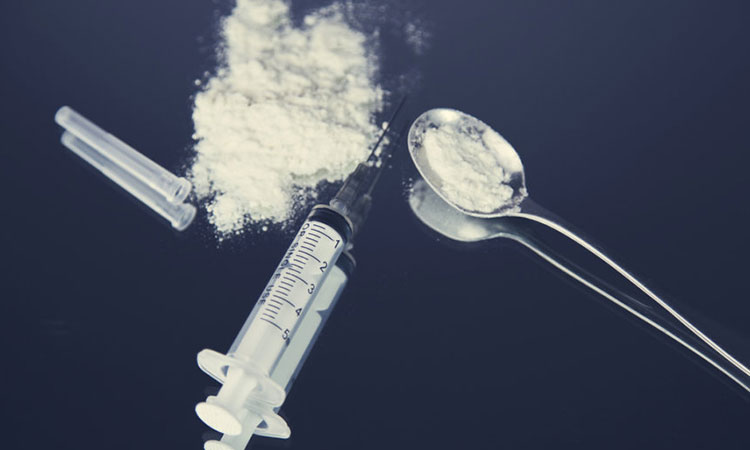
Heroin, or diamorphine hydrochloride, is an illicit drug derived from morphine. The primary methods of heroin use include injecting, smoking, and snorting.
Snorting heroin typically involves inhaling the drug’s powdered form into the nasal cavity, usually with a straw or rolled up paper. Heroin then enters the bloodstream through the nose before it makes its way into the brain.
People who snort heroin face a unique set of risks in addition to the usual set of side effects and complications. These include:
- Asthma attacks
- Nosebleeds
- Breathing issues
- Viral and bacterial infections in the nasal passage
- Damage to the sinuses, septum, and surrounding nasal tissu[/su_box]
Snorting Vs. Injection
Snorting heroin is unlikely to result in the intensity of injection – at least at first. When injecting, the user can experience a high within seconds – when snorted, however, it may take up to 15 minutes for the user to feel the initial effects.
After the first rush is over, however, the effects of both delivery methods can be quite similar.
People may choose to snort heroin over injection for a few different reasons. For one, some people don’t like needles and/or are trying to avoid the tell-tale signs of drug use, such as track marks and sores. Two, intravenous drug use faces a greater social stigma than snorting. Three, users may falsely believe that snorting is less addictive or dangerous than injecting.
Snorting Vs. Smoking
Smoking heroin, also known as “chasing the dragon.” To smoke heroin, users burn the drug and inhale the smoke into their lungs. Users who smoke heroin for extended periods face the increased risk of bronchitis, pneumonia, and other infections.
Effects of Snorting Heroin
The intensity and duration of effects associated with snorting heroin will vary depending on individual factors such as tolerance, as well as the purity/potency of the drug, frequency/amount used, and method of administration.
Side effects may include, but are not limited to the following:
- Itchiness
- Alternating wakefulness and sleepiness
- Nausea and vomiting
- Constipation
- Sleep disturbances
- Breathing problems
- Changes in libido (sex drive)
- Malnutrition, dehydration, and weight loss
Heroin Addiction

Users who snort heroin face the same risk of addiction as those who smoke or inject it. Addiction is essentially made up of two conditions – tolerance and dependency. Tolerance occurs as the body becomes desensitized to heroin use and more and more of the drug is needed to achieve the desired high.
When dependency occurs, the body has become used to the drug’s presence and can no longer function normally. Dependency also results in withdrawal symptoms when the user tries to quit or cut back.
Snorting Heroin – Withdrawal Symptoms
While rarely fatal, complications from heroin withdrawal (also known as “dope sick” are one of the main factors behind relapse. Highly unpleasant symptoms can start as soon as six hours after the last use, and peak 1-3 days. It can take close to a week for the acute effects of withdrawal to abate.
Typical withdrawal symptoms include, but are not limited to the following:
- Dysphoria (unpleasant mood)
- Nausea and vomiting
- Sweating and chills
- Goosebumps
- Muscle aches and pains
- Increased eye-watering, runny nose
- Fever
- Diarrhea
- Insomnia or sleep disturbances
- Irritability
- Increased sensitivity to pain
Snorting Heroin and Overdose
Snorting heroin, just like any other method of delivery can result in an overdose. The number of heroin overdoses has consistently climbed in the United States in the last few years, largely due to the presence of fentanyl.
Fentanyl is a synthetic opioid similar in effect to heroin, but up to 50 times more potent. Because it is easier and less expensive to manufacture than its opiate counterpart, dealers often cut fentanyl into heroin to increase the effects and maximize profits.
Both heroin and fentanyl are powerful central nervous system (CNS) depressants and use frequently results in life-threatening complications.
Symptoms of Heroin/Fentanyl Overdose include:
- Shallow breathing
- Low blood pressure (hypotension)
- Weak pulse
- Small pupils
- Discolored tongue and dry mouth
- Bluish lips and nails
- Stomach or intestine spasms
- Delirium, disorientation, and confusion.
- Uncontrollable muscle movements
- Extreme drowsiness
- Respiratory suppression
- Unresponsiveness/unconsciousness
- Coma
- Respiratory arrest (stopped breathing)
- Death
Treatment for Heroin Addiction
Heroin addiction is a very dangerous condition that can result in sudden death due to respiratory arrest. Heroin addiction is not curable, but it is treatable using long-term therapeutic approaches to drug dependency.
Treatment begins with a medical detox and continues with an inpatient or intensive outpatient program. Inpatients stay around-the-clock at our treatment center for a recommended minimum of 30 days. Outpatients visit the center a few times per week but reside at a private residence outside of our facility.
Both programs include modern, evidence-based approaches to addiction, such as psychotherapy, individual and group therapy, family counseling, group support, aftercare support, and alternative practices such as meditation and yoga.
Our programs are structured with various components of evidence-based treatment practices and holistic approaches to treatment that provide our patients with the knowledge and tools they need to be successful in their recovery.
If you or your loved one is suffering from substance abuse, please seek help as soon as possible.